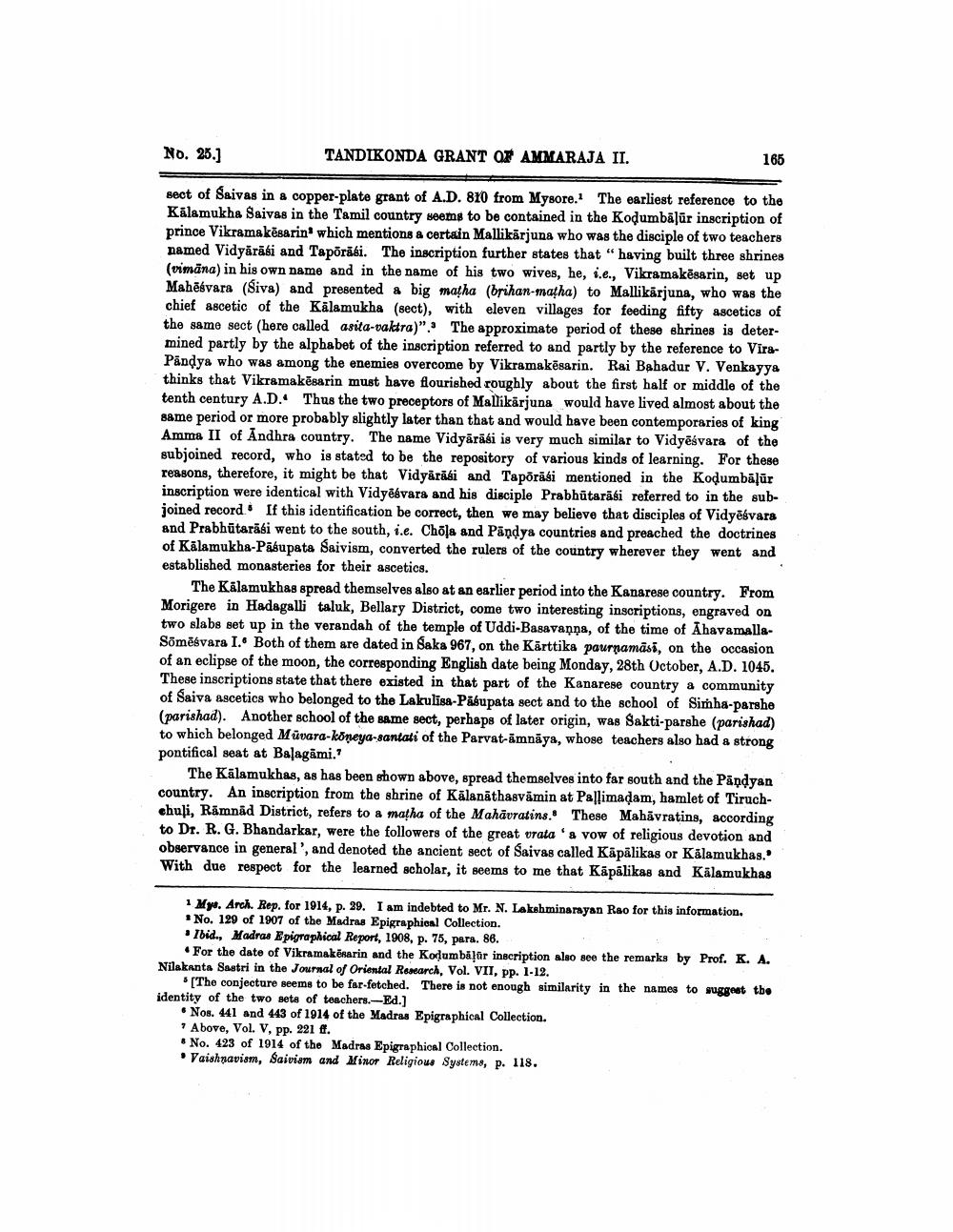________________
NO. 25.)
TANDIKONDA GRANT OF AMMARAJA II.
165
sect of Saivas in a copper-plate grant of A.D. 810 from Mysore. The earliest reference to the Kālamukha Saivas in the Tamil country seems to be contained in the KodumbāJūr inscription of prince Vikramakēsarin which mentions a certain Mallikarjuna who was the disciple of two teachers named Vidyārāsi and Tapõrābi. The inscription further states that "having built three shrines (vimäna) in his own name and in the name of his two wives, he, i.e., Vikramakësarin, set up Mahēsvara (Siva) and presented a big matha (brihan-matha) to Mallikarjuna, who was the chief ascetic of the Kālamukha (sect), with eleven villages for feeding fifty ascetics of the same sect (here called asita-oaktra)". The approximate period of these shrines is determined partly by the alphabet of the inscription referred to and partly by the reference to ViraPandya who was among the enemies overcome by Vikramakēsarin. Rai Bahadur V. Venkayya thinks that Vikramakēsarin must have flourished roughly about the first half or middle of the tenth century A.D. Thus the two preceptors of Mallikarjuna would have lived almost about the same period or more probably slightly later than that and would have been contemporaries of king Amma II of Andhra country. The name Vidyārāsi is very much similar to Vidyēsvara of the subjoined record, who is stated to be the repository of various kinds of learning. For these reasons, therefore, it might be that Vidyārāki and Tapõrāsi mentioned in the Kodumbāļūr inscription were identical with Vidye vara and his disciple Prabhūtarăsi referred to in the subjoined record. If this identification be correct, then we may believe that disciples of Vidyēsvara and Prabhūtarăbi went to the south, i.e. Chola and Pandya countries and preached the doctrines of Kälamukha-Pasupata Saivism, converted the rulers of the country wherever they went and established monasteries for their ascetics.
The Kalamukhas spread themselves also at an earlier period into the Kanarese country. From Morigere in Hadagalli taluk, Bellary District, come two interesting inscriptions, engraved on two slabs set up in the verandah of the temple of Uddi-Basavaņņa, of the time of ĀhavamallaSömēsvara I.. Both of them are dated in Saka 967, on the Kärttika paurnamāsi, on the occasion of an eclipse of the moon, the corresponding English date being Monday, 28th October, A.D. 1045. These inscriptions state that there existed in that part of the Kanarese country a community of Saiva ascetics who belonged to the Lakulisa-Pabupata sect and to the school of Simha-parshe (parishad). Another school of the same sect, perhaps of later origin, was Sakti-parshe (parishad) to which belonged Müvara-koneya-santati of the Parvat-imnāya, whose teachers also had a strong pontifical seat at Balagami.
The Kālamukhas, as has been shown above, spread themselves into far south and the Pandyan country. An inscription from the shrine of Kälanāthasvämin at Pallimadam, hamlet of Tiruchchuli, Râmnad District, refers to a matha of the Mahāvratins. These Mahāvratins, according to Dr. R. G. Bhandarkar, were the followers of the great vrata a vow of religious devotion and observance in general', and denoted the ancient sect of Saivas called Käpälikas or Kalamukhas. With due respect for the learned scholar, it seems to me that Käpälikas and Kālamukhas
1 Mys. Arch. Rep. for 1914, p. 39. I am indebted to Mr. N. Lakshminarayan Rao for this information. • No. 129 of 1907 of the Madras Epigraphical Collection. • Ibid., Madras Epigraphical Report, 1908, p. 75, para. 86.
For the date of Vikramakënarin and the Kodumbāļür inscription also see the remarks by Prof. K. A. Nilakanta Sastri in the Journal of Oriental Research, Vol. VII, pp. l-12.
[The conjecture seems to be far-fetched. There is not enough similarity in the names to suggest tbo identity of the two sets of teachers.-Ed.)
• Nos. 441 and 443 of 1914 of the Madras Epigraphical Collection.
Above, Vol. V, pp. 221 ff. * No. 423 of 1914 of the Madras Epigraphical Collection.
Vaishnaviam, Saiviam and Minor Religiowe Systems, p. 118.




